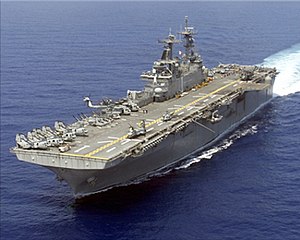Wasp-class amphibious assault ship

USS Wasp (LHD-1), in March 2004.
|
|
| Class overview | |
|---|---|
| Name: | Wasp class |
| Builders: | Ingalls Shipbuilding |
| Operators: |
|
| Preceded by: | Tarawa class |
| Succeeded by: | America class |
| Cost: | Roughly $1.5 billion |
| In commission: | 1989–present |
| Completed: | 8 |
| Active: | 8 |
| General characteristics | |
| Type: | Landing Helicopter Dock (LHD) amphibious assault ship |
| Displacement: | 40,500 long tons (41,150 t) full load |
| Length: | 843 ft (257 m) |
| Beam: | 104 ft (31.8 m) |
| Draft: | 27 ft (8.1 m) |
| Propulsion: |
|
| Speed: | 22 knots (41 km/h; 25 mph) |
| Range: | 9,500 nautical miles (17,600 km; 10,900 mi) at 18 kn (33 km/h; 21 mph) |
| Boats & landing craft carried: |
|
| Troops: | 1,894 Marine Detachment |
| Complement: | 1,208 |
| Sensors and processing systems: |
|
| Armament: |
|
| Aircraft carried: |
|
The Wasp class is a class of Landing Helicopter Dock (LHD) amphibious assault ships operated by the United States Navy. Based on the Tarawa class, with modifications to operate more advanced aircraft and landing craft, the Wasp class is capable of transporting almost the full strength of a United States Marine Corps Marine Expeditionary Unit (MEU), and landing them in hostile territory via landing craft or helicopters. All Wasp-class ships were built by Ingalls Shipbuilding, at Pascagoula, Mississippi, with the lead ship, USS Wasp, commissioned on 29 July 1989. Eight Wasp-class ships were built, and as of 2016[update], all eight are active.
The Wasp class is based on the preceding Tarawa-class design. The design was modified to allow for the operation of AV-8B Harrier II aircraft and Landing Craft Air Cushion (LCAC) hovercraft, making the Wasp class the first ships specifically designed to operate these.
The main physical changes between the two designs are the lower placement of the ship's bridge in the Wasp class, the relocation of the command and control facilities to inside the hull, the removal of the 5-inch (127 mm) Mk 45 naval guns and their sponsons on the forward edge of the flight deck, and a lengthening of 24 feet (7.3 m) to carry the LCACs.
...
Wikipedia
